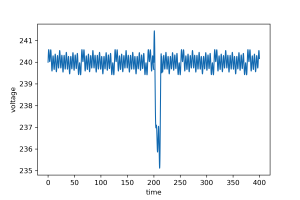Flicker in electrical systems

Imagine you are relaxing on your couch after a hard day of work watching a movie on TV. Suddenly, your TV starts to buzz, and the ceiling lights start to flicker. No, you are not in the middle of a new horror movie – you are just experiencing the effects of electrical flicker.
Flicker – terminology
In electrical engineering, flicker is defined as short-term voltage fluctuations in the power supply system. This can cause lamps to flicker, as the brightness is proportional to the applied voltage. Other technical devices are also sensitive to voltage fluctuations. Power supplies or TV receivers can have their function disrupted or, in extreme cases, even be destroyed by flicker.

Example of what flicker could look like
One should not neglect psychological effects of flicker either. Some people hardly notice a flickering light, but others find it very disturbing. A sensitive person who works all day in an office with flickering light may therefore exhaust more quickly or even develop headaches.
Nowadays, many electronic devices have built-in mechanisms to compensate for flicker. However, since such precautions quickly add up in terms of price and size, flicker-prone devices are still no rarity. Furthermore, voltage fluctuations can reach such an extend that existing protective mechanisms are no longer sufficient. This is precisely why flicker is and remains one of the most important parameters for evaluating power grid quality.
Causes of flicker
The causes of short-term voltage fluctuations can be manifold. For example, your neighbor could power on a large electric motor (e.g. a circular saw). This causes an above-average amount of electrical power to flow into the motor for a short time, which leads to a drop of voltage in the surrounding area. To avoid this, many modern electric motors have a soft-start function built in.
However, even electronic components that hardly require any power can cause flicker. The reason for this is that electrical devices connected to the mains have a feedback effect to the mains. For example, it would be possible for a kitchen mixer to send irregular voltage signals back to the power grid. In sum, this means that many small devices can have a significant impact on the power grid.
Power plants, especially wind turbines, can also generate flicker in the power grid. This is due to the formation of harmonics in the power plants. You can read more about this in our blogpost about harmonics in wind power plants.
Classification and measurement
To measure flicker, one always has to take a psychological component into account. This is usually included in the calculation by means of an empirically determined flicker curve. This curve indicates how strongly light fluctuations are perceived on average by a person. The frequency and strength of the voltage fluctuation do also play a role.
To classify the intensity of flicker one often uses so called perceptibility units P. There are three different types of perceptibility units:
- P_inst: current flicker perception.
- P_st: short-term flicker strength. This is the average over a period of 10 minutes.
- P_lt: long-term flicker strength. This is the average over a period of 2 hours.
Flicker is a phenomenon that manifests itself in very short voltage fluctuations. Therefore, it also requires high-quality measuring instruments to be able to measure flicker accurately. Also, the measurement should be done in a controlled environment because electrical components can behave differently depending on temperature or load. Nevertheless, the test environment should reflect the actual operating location of the device as well as possible.
OXYGEN – The perfect software for flicker detection
OXYGEN is a software for data acquisition and evaluation, developed by DEWETRON. During the development of OXYGEN, we put a focus on an intuitive and simple interface. Nevertheless, the feature set of OXYGEN is large. You can choose from a variety of software modules, depending on what best suits your needs.
For the analysis of flicker emissions, OXYGEN’s Power-Advanced feature is the way to go. This feature allows you to evaluate short-term voltage fluctuations according to the IEC 61000-4-15 and 61400-21 standards. One of many functions is of course the calculation of the above-mentioned P-values. You can find more details about our Power-Advanced feature in this blogpost or the corresponding video tutorial.
If you would like to learn more about OXYGEN, please visit the DEWETRON website. There, in addition to OXYGEN, you will also find a range of high-precision and modular measuring devices. Additionally, we offer a number of video tutorials, whitepapers and much more. You can also follow us on LinkedIn and YouTube, where we are regularly active.





